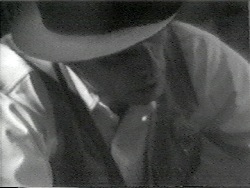Willoughby Sharp
Biography
Willoughby Sharp, a founder and publisher of the seminal art magazine Avalanche (1970-76), has over the past four decades gained international recognition as an artist, author, curator and teacher.
Sharp began his media work in 1967 with 8mm, Super 8mm and 16mm films, including Earth (1968) and Place & Process (1969), which was included in the landmark 1971 exhibition Information at The Museum of Modern Art. He then began producing video sculpture, video installations, "Videoviews" (1970-74), "Videoperformances" (1973-77), Transmission Art works (1977-present), cable television programs (1985-86), and broadcast TV programs (2001 -present).
In 1970, he began the "Videoviews" series of videotaped dialogues with Bruce Nauman (1970), Joseph Beuys (1972), Vito Acconci (1973), Chris Burden (1973), Lowell Darling (1974), and Dennis Oppenheim (1974). In 1976, he produced Five Video Pioneers: Acconci, Serra, Sharp, Sonnier, Wegman. The following year he represented the United States in the 37th Venice Biennale. More recently Sharp has produced a series of documentary programs on Dennis Oppenheim, Keith Sonnier, Earle Brown, and Morton Subotnick.
In the late 1970s, Sharp began a series of multi-casting, pre-Internet projects that interlaced information from computers, telefax, and Slow-Scan TV. In 1977, he instigated the first artists' trans-continental satellite work, Send/Receive's Two Way Demo. In 1979, he implemented MASERS (Mobile Artists Satellite Earth Receiving Stations), which allowed him to scan global satellite television programming and show it on a monitor.
Sharp has been a contributing editor of Impulse, Toronto, (1979-81); Video, San Francisco (1980-82); Art Com, San Francisco (1984-85), and The East Village Eye, New York (1984-86). He has contributed to Artforum, Art In America, Arts, Avalanche, and Flash Art, among others. He curated POP ART at Columbia University, New York, 1964; Robert Rauschenberg Retrospective, Krefeld Museum, Germany, 1964; Air Art, University Art Museum, Berkeley, CA.; Earth Art, Cornell University, Ithaca, NY; 1969; BodyWorks, Museum of Conceptual Art, San Francisco, CA., 1970; VIDEOPERFORMANCE, 112 Greene Street Gallery, New York, 1974; and the Film/Video section, Joseph Beuys Retrospective, The Solomon R. Guggenheim Museum, New York, 1979-80, among others.
His works are in the collections of The Museum of Modern Art, N.Y.; The Solomon R. Guggenheim Museum, N.Y.; ZKM (Zentrum fur Kunst und Medientechnologie), Karlsruhe, Germany; The Collection of the Venice Biennale, Venice, Italy; The National Art Gallery, Ottawa, Canada, among others. He has taught at School of Visual Arts, New York (1984-88); University of Rhode Island, Kingston, where he was also the director of the Fine Arts Center (1988-90); and New School University, Parson's School of Design, Graduate Faculty, Digital Design Department, New York (2000-2003).
In 2006, with Pamela Seymour Smith, Sharp began work on The Videobook: Willoughby Sharp's Oral Art History, a comprehensive video oral history of his activities in the art world from the late 1950s to the present. Sharp's forthcoming solo shows include Einstein's Eye at the Sculpture Center, NY in 2007 and a career retrospective, Retrospection, at Clifford Gallery, Colgate University, Hamilton, NY in 2007. Sharp was born in 1936 in New York City and lives in Brooklyn, New York.
